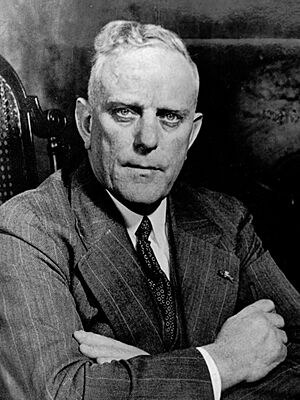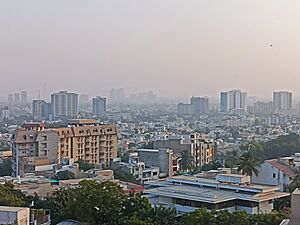Albert Plesman facts for kids
Albert Plesman (born September 7, 1889 – died December 31, 1953) was a Dutch aviation pioneer. He was the first leader and later director of KLM. KLM is the oldest airline in the world that still uses its original name.
Albert Plesman was the CEO of KLM for over 35 years until he passed away. Under his leadership, KLM became one of the most important airlines in the world.
He was born in The Hague as the son of an egg trader. In 1915, he joined the Dutch air force as an officer. This was during World War I, though the Netherlands stayed neutral. After the war, he started organizing the ELTA. This was the "First Aviation Exhibition Amsterdam." It took place from August 1 to September 14, 1919. Huge halls were built for this event. After the exhibition, Anthony Fokker used these halls for his new company. This company was the Nederlandse Vliegtuigenfabriek, which later became the Fokker airplane factory.
All these activities led to the creation of Royal Dutch Airlines (KLM). Plesman became its director and made it a very successful company. After World War II, Plesman was named president-director of KLM. The airline recovered from the war and became famous under his guidance. On February 25, 1946, KLM made the first flights from Europe to the USA. For his hard work, he received an honorary doctorate in 1947. This was from the Technical University of Delft. Plesman wanted to move Schiphol Airport to a new spot. But his idea was not chosen. The "father of KLM" died in The Hague on December 31, 1953, at age 64.
Contents
Early Life and Education
Albert Plesman was born on September 7, 1889. His father, Johan Cornelis Plesman, was an egg trader. His mother was Hendrika van Wessel. Albert was one of seven children. He grew up in a Protestant family. He attended the Hogere Burgerschool, a special school in The Hague. There, Albert showed great skill in mathematics. This sparked his interest in commercial aviation.
After his mother died and he finished school, Plesman joined the Alkmaar Cadet School. This was to prepare for service in the Royal Dutch East Indies Army. He then went to the Royal Military Academy in Breda, Netherlands. Here, he first explored his interest in aviation. He could visit the Gilze-Rijen airfield. Plesman began his service as a 2nd lieutenant. This gave him more chances to learn about aviation. He met a pilot named W. C. J. Versteegh. This pilot flew a Farman F.20 plane. Plesman was able to learn about flying from Verstegh. In April 1917, Plesman officially became a student pilot.
Albert Plesman met Susanna Jacoba van Eijk in early 1917. They got married in December of that year. They had three sons and one daughter. He was known as a great family man. He believed family time was very important. He often brought his children to important company meetings. This was unusual for someone in his position.
Building KLM and Aviation Success
Albert Plesman, along with Anthony Fokker, helped create two big aviation companies in Europe. These were KLM and Fokker. Europe became better connected with North America because of Plesman. He pioneered the first commercial transatlantic services. Thanks to Plesman's work at KLM, cargo, mail, and passenger services grew greatly.
KLM's first paid flight went from London's Croydon Airport to Amsterdam Airport Schiphol. KLM first rented its aircraft. But soon, they started using Fokker planes. These Fokker aircraft were a result of the leadership of Anthony Fokker and Albert Plesman. They made planes and then used them for commercial flights. This led to huge growth in travel within Europe, to North America, and to the Dutch colonies in Southeast Asia. In 1921, Albert Plesman also set up the world's largest aircraft repair and maintenance plant. This plant was at Amsterdam Airport Schiphol. KLM focused most of its work there. Plesman started building the new KLM headquarters in The Hague in 1939.
Plesman promoted clear business ideas for KLM. He believed in offering good quality at a fair price. He wanted to grow the company's presence in the market. He also aimed for competitive costs and a strong financial base. KLM then switched from wooden Fokker planes to metal aircraft. These new planes were made in the United States, as Plesman decided.
In late 1939, Albert Plesman had to stop all of KLM's flights. This was because of the Second World War. His aircraft were taken, and Amsterdam Airport Schiphol was only used by the military. He started flights again in 1946. When KLM was restarted, he became president of the company. He brought in Douglas aircraft. He also allowed the Dutch government to buy shares in KLM. This meant the airline became more nationalized.
He wrote a short book called Plan for international cooperation. This was likely published in 1950.
Albert Plesman died on December 31, 1953. He left the company to Fons Aler. The airline kept growing, even with money problems in the late 1950s. This was partly because the Dutch government owned more of the company.
Awards and Honors
- Knight of the Order of Orange-Nassau (1925)
- Officer of the Order of Orange-Nassau (1931)
- Knight of the Order of the Netherlands Lion (1934)
- Commander of the Order of Orange-Nassau (1949, at KLM's 30th anniversary)
- Knight of the Order of the Dannebrog (Denmark, 1931)
- Officer of the Order of Leopold II (Belgium, 1932)
- Officer of the Order of Vasa (Sweden, 1932)
- Commander of the Order of Leopold II (Belgium, 1935)
- Commander of the Order of the White Lion (Czechoslovak, 1935)
- Honorary doctorate from the Technical University of Delft (1947)
- The first Edward Warner Award, for his work in international civil aviation (International Civil Aviation Organization, given after his death, 1959)
- C.J. Snijders Medal
Television Series
Turbulent Skies is a Dutch TV series from 2020. It has eight episodes. It shows the achievements of Plesman and Anthony Fokker.



